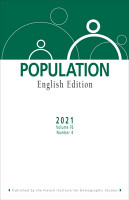
Population 2021, n°4
2021
Recent Demographic Trends in France. The Disruptive Impact of COVID -19 on French Population Dynamics: Fewer Births and Marriages, a Downturn in Migration, More Deaths…
Didier Breton, Nicolas Belliot, Magali Barbieri, Hippolyte d’Albis, Magali Mazuy
The Demography of Australia’s Same-Sex Marriage ‘Pioneers’: Results from the First Year of Marriage Equality
Fiona Shalley, Tom Wilson
‘Fatal Secrets’ and the Silent Contraceptive Revolution of Late 18th-Century France: ‘C’est le secret du vinaigrier’?
Laura Drewett
Subnational Consistency in Cause-of-Death Data: The Cases of Russia, Germany, the United States, and France
Inna Danilova, Roland Rau, Magali Barbieri, Pavel Grigoriev, Dmitri A. Jdanov, France Meslé, Jacques Vallin, Vladimir M. Shkolnikov
Recent Demographic Trends in France. The Disruptive Impact of COVID -19 on French Population Dynamics: Fewer Births and Marriages, a Downturn in Migration, More Deaths…
Didier Breton, Nicolas Belliot, Magali Barbieri, Hippolyte d’Albis, Magali Mazuy
On 1 January 2021, the population of France was 67.4 million, 120,000 more than on 1 January 2020. Unlike many European countries, the French population did not decline, but growth slowed sharply due mainly to the COVID-19 pandemic, which affected all components of population change. Provisional data indicate that the number of residence permits valid for at least 1 year granted to third-country nationals likely fell in 2020 (–10,000), particularly among immigrants from Africa and those entering France for family or humanitarian reasons. Births also fell sharply, with a spectacular dip 9 months after the lockdown. This drop reflects a decrease in the number of conceptions and not an increase in abortions, whose number fell in 2020, notably in the months following the first lockdown. But the two demographic events most affected by the pandemic were marriages, which became impossible because of strict social distancing rules imposed during lockdown (–70,000), and, as expected, mortality. Life expectancy fell by 0.56 years for males and 0.45 years for females, dropping back to the levels observed 6 years previously.
The Demography of Australia’s Same-Sex Marriage ‘Pioneers’: Results from the First Year of Marriage Equality
Fiona Shalley, Tom Wilson
In late 2017, Australia became the 27th country to legalize same-sex marriage, although little is known about the partners’ characteristics. To present a demographic profile of the same-sex couples who married, we assembled a unique dataset of all Australian marriages in 2018 using information supplied by state and territory registries. Estimates of Australia’s sexual minority population allowed us to calculate crude marriage rates for the population aged 18 and older for the first time. The rate of female same-sex marriage was higher than that of male samesex marriage and nearly double that for different-sex marriage. Partners in same-sex marriages were generally older, and female same-sex marriages were more likely to include children born in a previous marriage. The Australian marriage data are consistent with many observations about same-sex marriage in a selection of other countries, but higher proportions of same-sex marriages were recorded in Australia’s first year compared to
initial trends in these countries.
‘Fatal Secrets’ and the Silent Contraceptive Revolution of Late 18th-Century France: ‘C’est le secret du vinaigrier’?
Laura Drewett
France led Europe’s fertility transition, preceding other countries by a century. Whether this 18th-century shift was driven by socio-economic forces or diffusion of new birth control methods or ideals has never been definitively concluded. This article considers if the contribution of rudimentary spermicides to France’s transition has been underestimated, arguing that they were subtly normalized and democratized under the guise of cosmetic vaginal astringents during France’s consumer revolution. That this occurred during the fertility transition begs the question of whether these astringents had become synonymous with birth control. The article shows how an illicit market in pornographic novels publicized intravaginal birth control to the masses. A reevaluation of philosophical and demographic texts will suggest these astringents’ ability to impede fertility had been realized, even in rural areas. Such innovation combined with an appearance-led consumer revolution might have facilitated individualism and emancipated women from their traditional roles as mothers.
Subnational Consistency in Cause-of-Death Data: The Cases of Russia, Germany, the United States, and France
Inna Danilova, Roland Rau, Magali Barbieri, Pavel Grigoriev, Dmitri A. Jdanov, France Meslé, Jacques Vallin, Vladimir M. Shkolnikov
Dissimilarities in certifying and coding underlying causes of death may undermine the usefulness and reliability of cause-of-death statistics. Consistency in cause-specific mortality data within a country can be regarded as one criterion of data quality. This article assesses the subnational consistency in cause-of-death statistics in Russia, Germany, the United States, and France. We estimate the shares of major groups of causes in regional mortality structures and compare them with the interregional average values. We visualize the deviations on heat map matrices, pinpointing the cause–region combinations that deviate the most, the causes with high within-country
variability, and the regions with unique mortality structure. France has the most consistent cause-of-death data across its regions, while Russia has the largest number of outliers. We also found that causes of death with no strict diagnostic criteria tend to display higher variability, while the shares of more easily diagnosed underlying causes are stabler across regions.

